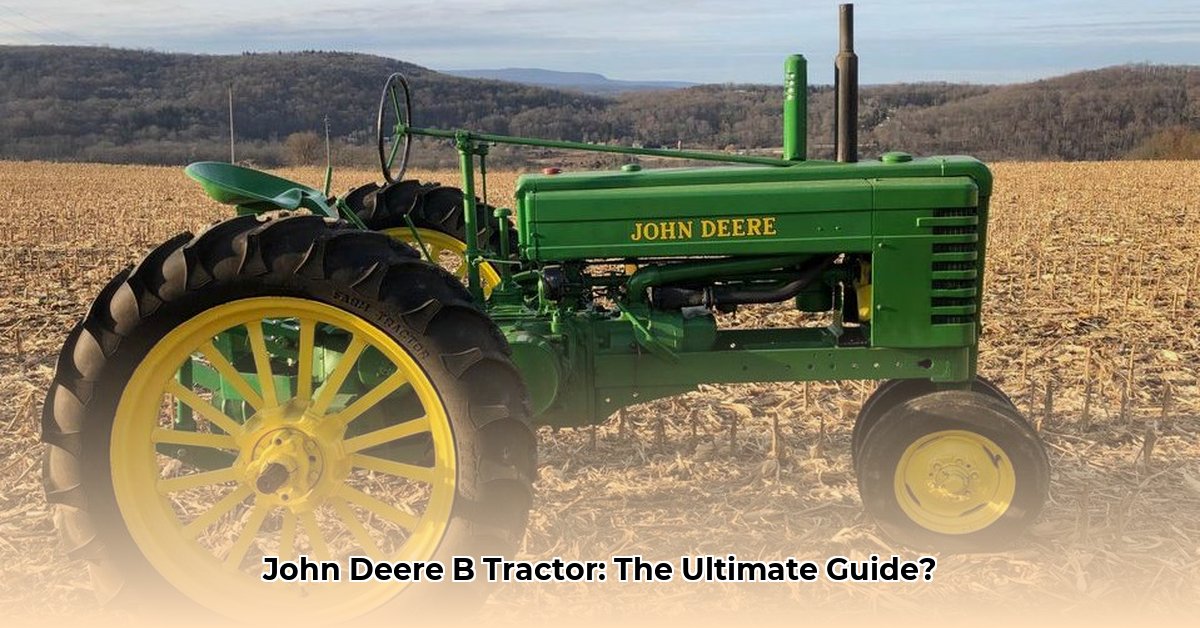
The John Deere B tractor: a legend. This iconic machine, produced from 1937 to 1952, continues to captivate farmers and collectors alike. Its enduring appeal stems from robust construction, simple mechanics, and a timeless design. This guide serves as your comprehensive resource, from understanding its history to securing your own piece of this agricultural legacy. Whether you're a seasoned collector or a first-time buyer, we'll equip you with the knowledge and tools to navigate the world of vintage John Deere B tractors with confidence. For more in-depth valuation resources, check out this helpful site: John Deere B values.
A Trip Through Time: The John Deere B's Evolution
The John Deere B's journey spans three distinct design periods, reflecting technological advancements and evolving aesthetics:
Unstyled (1937-1938): These early models embody functional simplicity, prioritizing durability over stylistic flourishes. Their straightforward design speaks volumes about the era's engineering focus.
Early Styled (1939-1947): A refined aesthetic emerges here. Noticeable improvements include more sculpted grillwork and a smoother hood design. These modifications signal a shift towards a more visually appealing machine.
Late Styled (1947-1952): The final iteration showcases further design refinements, representing the pinnacle of the John Deere B's stylistic evolution. These tractors boasted enhanced features and a more polished look, reflecting the post-war manufacturing boom.
Visual inspection is key to identifying these periods. [Insert Images of Early, Middle and Late Model Year John Deere B Tractors Here] These differences significantly impact a tractor's value, reflecting its place in the model's history.
Decoding the Market: Factors Affecting John Deere B Prices
The price of a John Deere B varies significantly, influenced by a complex interplay of factors. While the advertised horsepower can be inconsistent, a comprehensive assessment of the tractor provides a clearer picture. A fully restored tractor in excellent condition will demand a premium price, reflecting the investment in time and resources. Conversely, a project tractor requiring substantial work will command a lower price. Other significant factors include:
- Year of Manufacture: Earlier models, being rarer, generally fetch higher prices.
- Condition: The overall condition, including mechanical functionality and cosmetic appearance, heavily influences value.
- Features: Additional features, such as hydraulics or specific transmission types, can increase a tractor's desirability and price.
[Insert Chart or Graph Here: Visualizing Price Trends based on Year, Condition, and Features]. Understanding these dynamics allows you to make informed decisions and negotiate effectively.
Your John Deere B Buying Adventure: A Step-by-Step Guide
1. The Search: Begin your search online through auction sites, classifieds, and specialized forums. Network with fellow enthusiasts; often, private sellers possess unique finds. Verify the seller's reputation; cautious investigation is paramount. Remember that patience and persistence are key in searching for a suitable tractor. Finding a well-maintained tractor takes time, but it is worthwhile!
2. Pre-Purchase Inspection: This is arguably the most crucial step. Engage a qualified mechanic specializing in vintage tractors. A comprehensive inspection should include:
- Engine: Check for compression, unusual noises, leaks, and worn components.
- Transmission: Evaluate gear shifting smoothness and listen for any unusual sounds.
- Hydraulics: Test lift and steering responsiveness, and check for any leaks.
- Frame and Body: A meticulous check for rust, damage, and corrosion is essential.
- Electrical System: Testing the lights, starter, and other electrical components will provide a comprehensive overview.
3. Price Negotiation: Research comparable tractor sales to establish a realistic market value. Your pre-purchase inspection findings will provide justification for negotiation. A well-informed buyer confident of the tractor's condition and market value will be well-positioned to obtain a fair price. Remember, negotiation is a skill—it’s a rewarding process to learn.
4. Post-Purchase Actions: Register your tractor, secure appropriate insurance, and identify reliable parts sources. Plan for potential restoration needs and factor these costs into your budget.
Restoration and Maintenance: A Labor of Love
Restoring a John Deere B is a rewarding pursuit for dedicated enthusiasts. Common challenges include parts sourcing (often requiring diligent research and networking) and addressing issues such as engine wear, electrical faults, and hydraulic leaks. Prioritize restoration projects within your skill set or consider contracting experienced specialists.
Regional Variations: A Future Perspective
While comprehensive regional data is still being collected, preliminary findings suggest price variations based on local demand and collector communities. Areas with a high concentration of vintage tractor enthusiasts often exhibit higher prices, reflecting the dynamics of supply and demand. Further data analysis will clarify these regional differences.
Assessing the Risks: A Realistic Perspective
| Risk Category | Probability | Impact | Mitigation Strategy |
|---|---|---|---|
| Mechanical Failure | Moderate | High | Comprehensive pre-purchase inspection by a qualified mechanic. |
| Parts Availability | Moderate | Moderate | Thorough research of parts sources; engage with online communities. |
| Overpaying | Moderate | Moderate | Extensive market research and comparison shopping. |
| Hidden Damage/Restoration | High | High | Complete inspection; consider a professional appraisal. |
Buying a John Deere B is a significant investment, blending agricultural history with a rewarding hobby. Thorough preparation and meticulous planning are keys to success. Enjoy your journey!
[1] TractorData.com: http://tractordata.com/farm-tractors/000/0/2/26-john-deere-b.html